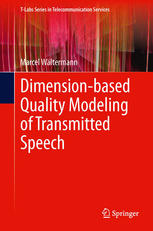

Most ebook files are in PDF format, so you can easily read them using various software such as Foxit Reader or directly on the Google Chrome browser.
Some ebook files are released by publishers in other formats such as .awz, .mobi, .epub, .fb2, etc. You may need to install specific software to read these formats on mobile/PC, such as Calibre.
Please read the tutorial at this link: https://ebookbell.com/faq
We offer FREE conversion to the popular formats you request; however, this may take some time. Therefore, right after payment, please email us, and we will try to provide the service as quickly as possible.
For some exceptional file formats or broken links (if any), please refrain from opening any disputes. Instead, email us first, and we will try to assist within a maximum of 6 hours.
EbookBell Team

4.0
26 reviewsIn this book, speech transmission quality is modeled on the basis of perceptual dimensions. The author identifies those dimensions that are relevant for today's public-switched and packet-based telecommunication systems, regarding the complete transmission path from the mouth of the speaker to the ear of the listener. Both narrowband (300-3400 Hz) as well as wideband (50-7000 Hz) speech transmission is taken into account. A new analytical assessment method is presented that allows the dimensions to be rated by non-expert listeners in a direct way. Due to the efficiency of the test method, a relatively large number of stimuli can be assessed in auditory tests. The test method is applied in two auditory experiments. The book gives the evidence that this test method provides meaningful and reliable results. The resulting dimension scores together with respective overall quality ratings form the basis for a new parametric model for the quality estimation of transmitted speech based on the perceptual dimensions. In a two-step model approach, instrumental dimension models estimate dimension impairment factors in a first step. The resulting dimension estimates are combined by a Euclidean integration function in a second step in order to provide an estimate of the total impairment.